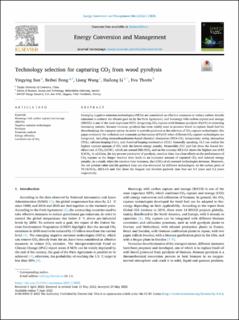| dc.description.abstract | Emerging negative emission technologies (NETs) are considered as effective measures to reduce carbon dioxide emissions to achieve the climate goal set by the Paris Agreement, and bioenergy with carbon capture and storage (BECCS) is one of the most important NETs. Integrating CO2 capture with biomass pyrolysis (PyrCC) is attracting increasing interest, because biomass pyrolysis has been widely used to produce biooil to replace fossil fuel for decarbonizing the transport sector. In order to provide guidance to the selection of CO2 capture technologies, this paper evaluated the technical and economic performances of PyrCC when different CO2 capture technologies are integrated, including monoethanolamine-based chemical absorption (MEA-CA), temperature swing absorption (TSA), calcium looping (CaL), and chemical looping combustion (CLC). Generally speaking, CLC can realize the highest capture amount of CO2 with the lowest energy penalty. Meanwhile, CLC and CaL show the lowest levelized cost of CO2 (LCOC), which are around 56$/tCO(2); and on the contrary MEA-CA shows the highest one of 83 $/tCO(2). In addition, the key process parameter of pyrolysis, reaction time, has clear effects on the performance of CO2 capture as the longer reaction time leads to an increased amount of captured CO2 and reduced energy penalty. As a result, when the reaction time increases, the LCOCs of all assessed technologies decrease. Moreover, the net present value and the payback time are also estimated for different technologies. At the carbon price of 70.1$/tCO(2), MEA-CA and CLC show the longest and shortest payback time that are 5.9 years and 3.2 years respectively. | en_US |

